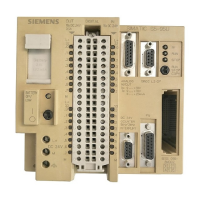Description of the Firmware
4–5
IP244
C79000–B8576–C860–02
1 Description of the Firmware
1.1 Functional Description of Temperature Control
/0' 1'0".
&) 1'0".
2 1'0".
)&+0'/"!
1-&'".
--*-
("..$".
*'"-) "
(*)&/*-&)$
4./"+ *0/+0/
(+'&)$
/&("
*--
./"+
./"+
"
+
)+0/ &- 0&/
&)"-&3/&*)
*(+")./&*)
1"-$&)$
0-/&*) *#
(*)&/*-&)$
".0-"! 1'0" ,0&.&/&*)
0'."
.%+&)$
./$"
4./"+ *0/+0/
0(0'/&1" ."/+*&)/.
-("/"-.
/&*)
/&*)
!
"/+*&)/
-(+&)$
"
")/-' *)/-*''"-
A Off switch for controllers (heating switch) T
N
Integral action time
AI 0 to 14 Analog inputs (channels 0 to 14) W Smoothed setpoint
AI 15 Compensation input (channel 15) W
e1
Temperature setpoint
HCR Heating-cooling ratio W
e2
Lower setpoint
H
D
Manual manipulated variable X
d
System deviation
K
P
Controller gain X
korr
Corrected analog value
T
D
Derivative action time
Fig. 1.1/1 Function diagram of the controller
The controllers are stored in the form of an algorithm in an EPROM as continuous controllers with
pulse output (pulse-duration modulated). The controllers are switching 2-step or 3-step controllers
with percentage output. The 13 control loops are processed cyclically in the processor section of
the module.
The module is configurable within certain restrictions. The firmware contains a set of functions from
which the required functions can be selected. This selection is made by setting bits in control bytes
and main control bytes.
The parameters for the controllers are transferred to the module for each controller separately in
one or two messages.

